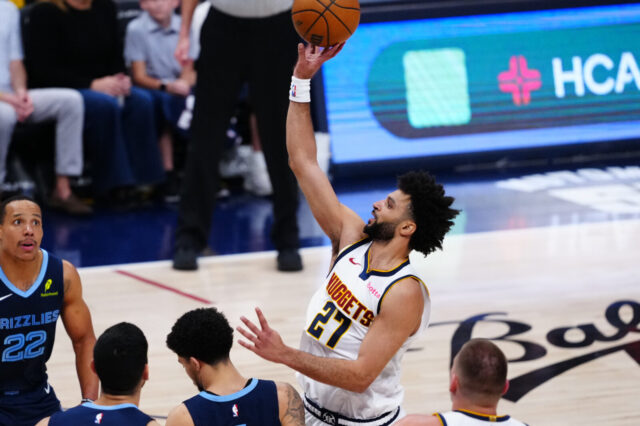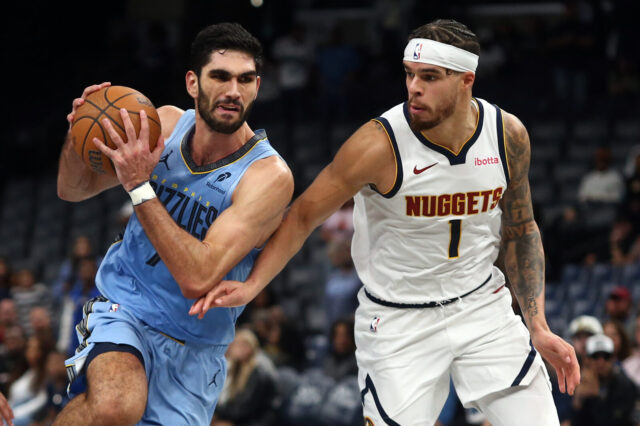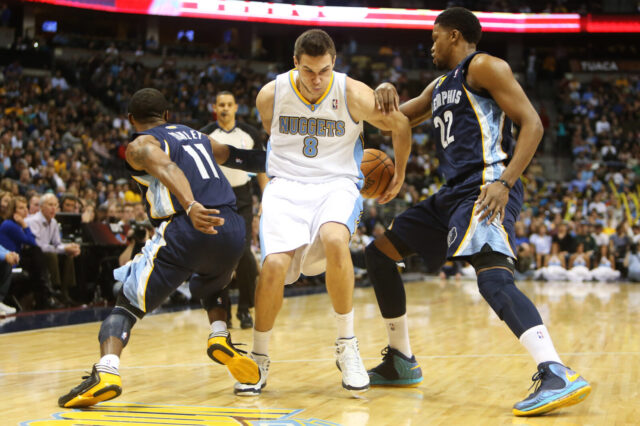Out of nowhere last season, Trey Lyles earned the respect of Denver Nuggets fans.
After Paul Millsap tore a ligament in his wrist early in the 2017-18 season, the Nuggets needed someone to step up and fill the void in the rotation. Many Nuggets fans expected upstart Juancho Hernangomez to fill the void. Instead, the newcomer Lyles stepped up, providing solid production off the bench across 73 games.
When Millsap returned, Lyles’ role diminished. In 2018-19, the dynamic power forward is looking to change that. After a stellar training camp and preseason, Lyles is in line for a career year in a Denver Nuggets uniform this season.
Offensive Versatility is the name of the game
Understanding exactly what Lyles provides offensively starts by understanding his shooting profile.
This content is no longer available.
Spotting Up
The most important factor of his offensive game, Lyles posted 1.1 points per possession in spot up scenarios. He demonstrated an excellent shooting stroke as the primary spot up option when Will Barton was handling the ball in bench lineups.
Spot Up attempts primarily show up in catch-and-shoot scenarios. Lyles attempted 2.6 catch-and-shoot three pointers per game, shooting 40.6 percent. This portion of his game was the foundation of his scoring, and it’s also the primary sticking point for his place in the rotation. Surrounding the trio of Nikola Jokic, Jamal Murray, and Gary Harris with competent shooters long term will help Denver maintain an elite offense. Lyles provided that in his age-22 season, and there’s no telling how much his shooting may improve as he progresses.
Driving off the catch is also a massive portion of Lyles’ game and fits under the spot-up category.
Offensively, Lyles’ best skills revolve around his physical attributes. At 6’10, he has the height to shoot over almost anybody on the floor, drawing defenders closer and closer to contest the jumper. The closer the defender comes, the more threatening Lyles becomes driving the basketball, as he shows with a quick burst to the rim from the top of the key. His solid frame helps him finish through contact and draw fouls. Lyles scored very frequently in these situations, producing points on 65.7% of his drives, a mark that placed him 15th in the NBA.
This content is no longer available.
Speaking to the media last week, Lyles told Nuggets reporters that he felt confident taking defenders off the dribble, saying that he was “trying to take what defenses give [him]” in order to best score the basketball.
Lyles’ driving ability works in tandem with his catch and shoot efficiency to put the defender closing out on him in a pickle. Either close out hard to prevent the 6’10 forward from a three-pointer he makes 40% of the time or sit back to prevent the drive on which he generates points 65% of the time. Of the most efficient scorers on drives in the graph above, only two added the threat of shooting 40% on catch-and-shoot threes: Kevin Durant and Kyrie Irving.
Rolling to the rim and posting up
As a roll man, Lyles was in the 67th percentile, an above average figure on decent volume. Denver’s offense, especially in a two big system, utilizes a below average number of roll man possessions (19th in play type frequency). Lyles, though, is intriguing based on plays like this one:
Technically classified as a cut, the above play shows what Lyles can do as a big target in the middle of a spread floor. Barton finds him easily here, and the primary reason, beyond catching the Spurs off guard, is that the weak side help comes from the corner and not the short corner. Lyles can make the pass to the short corner if need be, but it’s a much more difficult play than finishing over a mismatch.
It wouldn’t surprise me if the Nuggets take advantage of this by using Lyles more frequently with Nikola Jokic, a floor spacing center who can pass open players consistently. It’s easy to see a scenario where Lyles operates as the roll man with Jamal Murray, while Jokic surveys the floor from the opposite wing, ready to hit the high-low pass to Lyles or run a DHO with Gary Harris or Will Barton on the weak side.
Finally, posting up mismatches is Lyles’ bread and butter. 88th percentile is an elite mark, and playing with Jokic led to a number of plays like this one:
Denver’s offensive scheme forces a number of switches all over the floor so having a mobile, athletic, 6’10 weapon in Lyles makes things easier for everyone on the court.
Room for growth
There are definitely areas of improvement for Lyles this season, and it starts with his passing. After averaging just 1.2 assists per game last season, Lyles has shown some great growth in the preseason as a passer. In four preseason games thus far, Lyles has put up 18 assists, good for a 4.5 per-game average. It’s simple plays like this one that should have Nuggets fans excited:
Operating on the perimeter out of the pick and roll as a ball handler at 6’10 is a unique skill, and it’s Lyles’ next step toward complete positional versatility. Very few bench forwards and centers can guard a spot up threat who can also post up AND run both parts of the pick and roll.
Lyles has talked about his improvement as a passer, saying that the success he’s had in the preseason is a product of his aggressiveness off the dribble and collapsing the defense. At 6’10, it becomes easier to survey the court and hit the open man when there’s a comfort level handling the ball.
It also allows for Denver to be creative with how he’s utilized alongside Nikola Jokic. A 4-5 middle pick and roll between the two makes a lot of sense, as does a 5-4 inverted pick and roll with Jokic handling. Most teams will simply switch this matchup, but Jokic posting against nearly every power forward in the NBA is a matchup Denver would like, as is Lyles attacking against a center in open space.
Lyles can also improve as an option in transition. His athleticism isn’t about speed, but the smoothness with which he plays should lead to some easy baskets in the future. As Denver’s bench lineup finds more chemistry together and creates more turnovers, Lyles will be a beneficiary.
In addition, improving upon his baseline skills will turn him from an elite bench player into a starting caliber player. He attempted over 2.5 catch-and-shoot threes per game at a 40% clip, so why not try and make it 3.5 per game at a 42% clip? Going from 67th percentile in the pick and roll as the roll man to the 80th percentile would add to his value as a spot-up and post-up threat. Small pieces of his game can be improved and maximized upon, and the details will go a long way in solidifying his standing in the NBA.
Projecting forward
Nuggets fans should be excited about Lyles. Danilo Gallinari comes to mind for a number of fans when watching the 6’10 Lyles glide around the court and stretch the floor. A comparison of their statistics on a per 36 minute basis look awfully similar when compared to their year 22/23 seasons.
This content is no longer available.
I expect Lyles to average around 22 minutes per game this season behind Paul Millsap as Denver’s primary bench backup. He will spend most of his time at the power forward, but depending on the lineup may may move up to center or down to small forward. After averaging 9.9 points, 4.8 rebounds, and 1.2 assists last year, I see those numbers jumping to 12.0 points, 6.0 rebounds, and 2.5 assists in primarily bench minutes. For context, only one player in NBA history matched those numbers with plus efficiency as a bench player: Detlef Schrempf early in his career.
Nuggets fans should be excited to see what Trey Lyles can accomplish in a permanent role in Denver. Every indicator is pointing toward a breakout season, and Lyles seems to be ready for the challenge. Lyles’ versatility is an excellent individual weapon who can function within Denver’s scheme in multiple ways. If the Nuggets are willing to unleash him, he will wreck havoc on opposing defenses this year.


